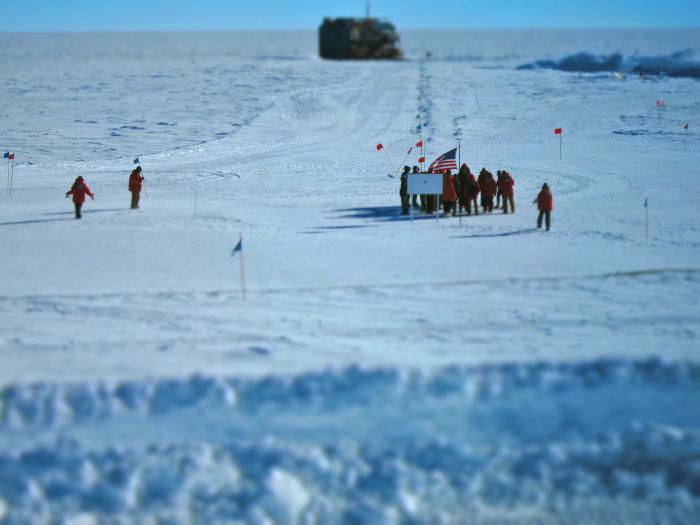A Place That Wants You Dead
southpole .....
Later: Friendly Radiation
Earlier: Marathon
Sunday, Jan. 16 2011 11:32 p.m. UTC

It’s a little before the lunch rush here in the galley and I’m using a bit of the quiet time here to write today’s post. From where I sit I can see nearly half the entire horizon — as close to a completely flat line as you can get, apart from being on an ocean-going boat, I suppose. There is a meditation technique in which one raises one eyes to whatever horizon, real or imaginary, is in front of one, and one simply watches thoughts arise and fall away. That horizon is nowhere more perfect than here.
The minimalism of the view means that any human construction (antenna, caterpillar tractor, futuristic building, or any of the many thousands of flag markers), no matter how distant, stands out in relief. That visual fact underscores a notion I have about this place. Except for featureless plains of snow, a wide-open sky, wind, and extreme cold, one’s experience of this place is almost exclusively that of humans and human-made things. No trees, no terrain, no insects or animals, no smells, nothing — except what we have brought here. In this way, this alien location is perhaps the most human place I will ever visit. Music in the galley, jokes over email and posted on the corridor walls, footsteps in the hallway outside your room while you’re trying to sleep, the fuel smells mixing with food cooking in the galley, one’s own body odors and those of one’s colleagues, and, most of all, one’s own mundane or esoterically technical work — these are the parameters of life here. The strange irony of this place is that it is all fellowship and craft, in one of the harshest spots on Earth.
There is a New York Times article today about Antarctic tourism commemorating Scott’s and Amundsen’s expeditions here:
Despite the potential circus atmosphere, some veterans insist that Antarctica is not for novices.
“It’s a place that wants you dead,” said Robert Swan, an environmentalist who walked Scott’s route to the South Pole in 1985. “Scott found that out 100 years ago.”
True enough — particularly for tourists who try to walk, ski, or drive here (yes, people do drive to the South Pole from time to time). But for us, ensconced relatively comfortably in this space station / aircraft carrier / submarine, it is certainly less hazardous than it was for Amundsen and Scott, and nothing more than human. When we visit the stars, we will take everything about ourselves with us… and that may provide the biggest challenge, and the biggest joy.
Yesterday after dinner I took a turn in the dish pit washing dishes. The galley serves 200 people for dinner and so there is a real after-dinner rush for the dishwashers; they rely partly on volunteers on Sunday (and Ricky, one of the dishwashers, had just finished winning the marathon). It was a pleasure to work fast, with my body and hands, to feel warm water and the spray of errant droplets on my face. Computer work is exceptionally hard to do with full-body awareness, but when washing dishes that awareness is an easy pleasure. Fleetwood Mac off of someone’s iPod kept the beat. The gratitude of the galley staff was palpable. It was a high point of this trip, simply to turn dirty dishes into clean ones.
The lunch crowd is building. Time to eat.
Later: Friendly Radiation
Earlier: Marathon